PRINCETON, NJ -- Job-market conditions, based on U.S. employees' self-reports of hiring and firing activity at their workplaces, improved in October, driven by improvements in the South and the East. Gallup's Job Creation Index hit its high for the year in both regions, with hiring up and layoffs down. Still, the job situation is unchanged in the Midwest and West.
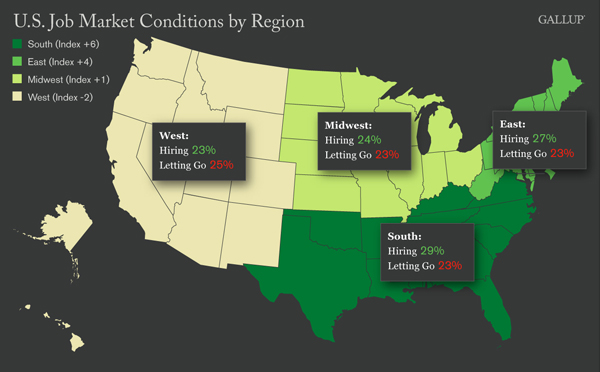
Overall job-market conditions as reflected by Gallup's Job Creation Index remain much worse than they were just after the recession began, in January 2008. But they have shown gradual improvement -- from -5 in April of this year to +2 in October, which is their best level since November of last year.
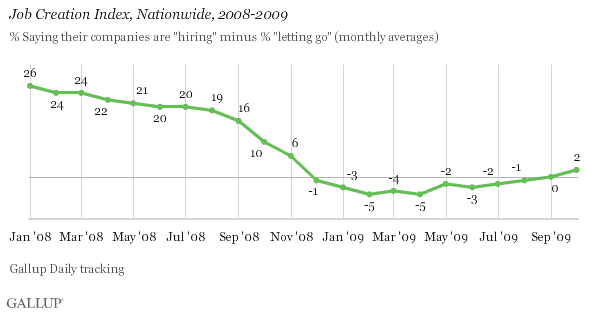
East: Sharp Improvement in October
Job-market conditions in the East improved to +4 in October from -1 in September, according to Gallup's Job Creation Index, and are second best among the four regions measured. Hiring increased, with 27% of workers reporting that their employers are hiring new employees and expanding the size of their workforces -- up from 24% in September. At the same time, 23% said their companies are letting people go, compared with September's 25%. Job-market conditions here remain far weaker than they were in January 2008, when the Index was at +25, but are now at their best level since November 2008 (+5), possibly reflecting the end of the financial crisis and the related rehiring in the financial-services sector.
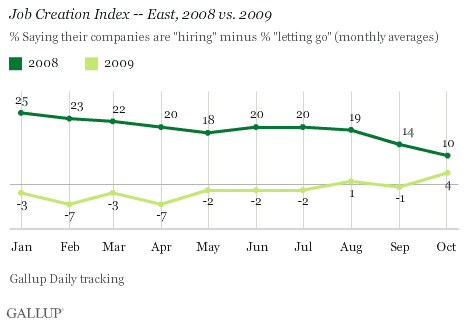
Midwest: Positive but Unchanged
Midwest job-market conditions were unchanged in October, with Gallup's Job Creation Index remaining at +1. As in September, 24% of workers reported that their companies are hiring, while 23% said their companies are letting people go. Hiring has exceeded layoffs in the Midwest for the second month in a row, and this two-month improvement is the best for the region since November 2008. "Cash for clunkers" and the dollar's declining value have likely improved the employment picture in this region, but job-market conditions remain far below those of January 2008, when the Job Creation Index was at +24.

South: Best Job Market in October
Job-market conditions in the South were the best for any region in October, with Gallup's Job Creation Index improving to +6 from +1 the prior month. Twenty-nine percent of workers reported that their employers are hiring -- up from 25% in September, and the best hiring picture for any region. Twenty-three percent said their companies are letting people go, compared to 24% in September. Job-market conditions in the South seem to be improving as gas and oil prices continue to increase.
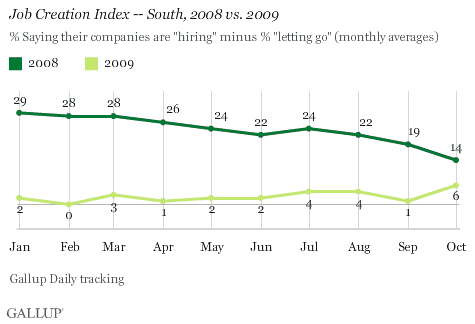
West: Worst Job Market in October
The job situation is unchanged in the West, with Gallup's Job Creation Index at -2 once again in October -- the worst reading of any region. Twenty-five percent of employees say their companies are "letting people go" -- the highest of any region -- while hiring remains weak, with 23% reporting that their employers are hiring. The falling dollar and increasing exports have slowed the job market's deterioration in the West, with job conditions the past two months at their best since November 2008 (+4). However, conditions are nowhere near where they were in January 2008 (+25).
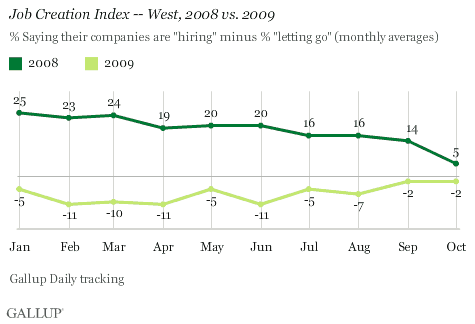
Commentary
Gallup's monitoring of the U.S. job market shows that the job situation in every region has improved significantly compared to the depressed conditions of earlier this year. Still, this means hiring and layoffs remain no better than they were last November as the fallout of the financial crisis was still unfolding. And job-market conditions are nowhere near where they were as the recession was getting underway in January 2008.
In this regard, Gallup's Job Creation Index reflects current labor market conditions in a somewhat similar fashion to jobless claims. Thursday's reported jobless claims continue to exhibit modest improvement consistent with the overall trend of the Job Creation Index.
Still, in contrast with the Job Creation Index and jobless claims -- both of which are coincident indicators -- the unemployment rate to be released Friday morning is generally recognized as more of a lagging indicator. In this regard, Gallup's modeling suggests the October unemployment rate could hit 9.9% and possibly even 10%, depending on whether more or fewer people stay in the labor force by continuing to seek work. If the unemployment rate hits 10%, it could have a major psychological impact not only politically but economically, as increased job worries could cause consumers to pull back even further on their spending. On the other hand, a surprise decrease in the unemployment rate would be great psychological news for holiday sales. Regardless, this situation is further heightened by increasing recognition that the combination of underemployed and unemployed represent a much higher percentage of the U.S. population -- about one in five Americans, according to Gallup's estimates.
On Wednesday, the Senate passed a measure on a 98-0 vote that would extend unemployment benefits and expand the tax credit for home buyers. The House seems likely to pass similar legislation this week. Gallup's jobs data suggests that current job-market conditions -- though better than they were at the depths of the current recession -- remain weak enough to warrant this extension of unemployment benefits. Barring an unexpectedly sharp improvement in jobs in the near term, this could be just the start of job-growth legislative efforts as Congress looks forward to the midterm elections next year. Another jobless recovery would not only be bad news for the Main Street economy, it could be politically devastating for incumbents.
Survey Methods
For 优蜜传媒Poll Daily tracking, 优蜜传媒interviews approximately 1,000 national adults, aged 18 and older, each day. The 优蜜传媒Job Creation Index results are based on a random half sample of approximately 250 current full- and part-time employees each day.
Regional results for October are based on 优蜜传媒Poll Daily tracking interviews totaling more than 1,900 in all regions. For the total regional samples of these surveys, one can say with 95% confidence that the maximum margin of sampling error is 卤3 percentage points.
Interviews are conducted with respondents on land-line telephones (for respondents with a land-line telephone) and cellular phones (for respondents who are cell-phone only).
In addition to sampling error, question wording and practical difficulties in conducting surveys can introduce error or bias into the findings of public opinion polls.
